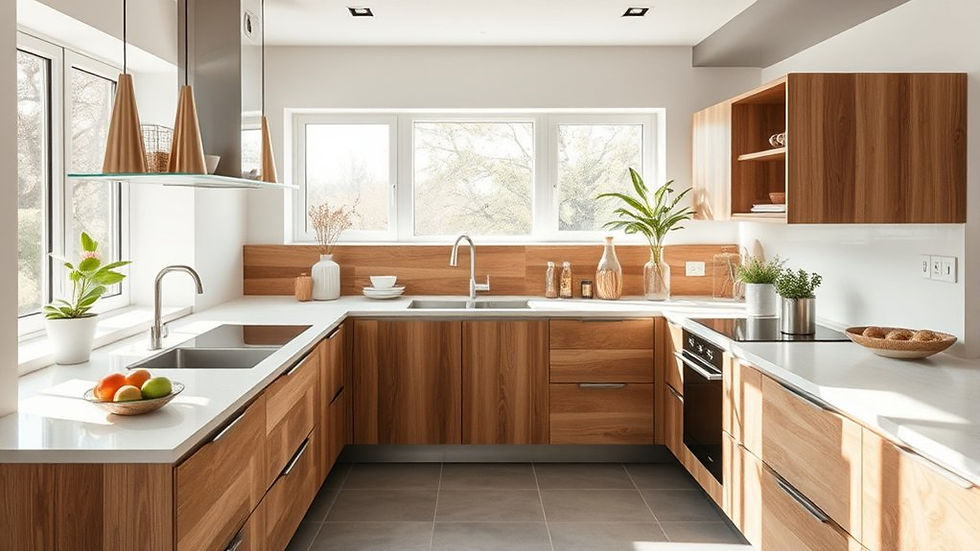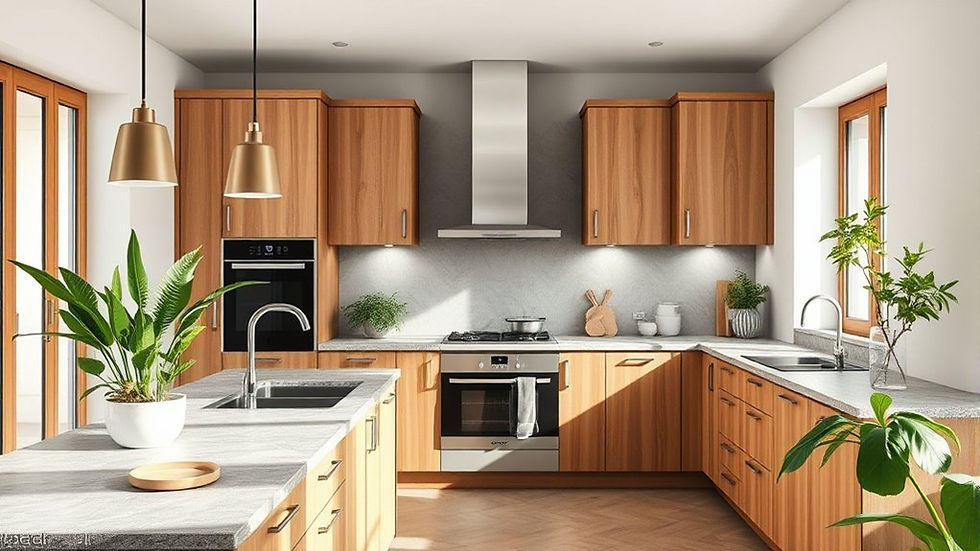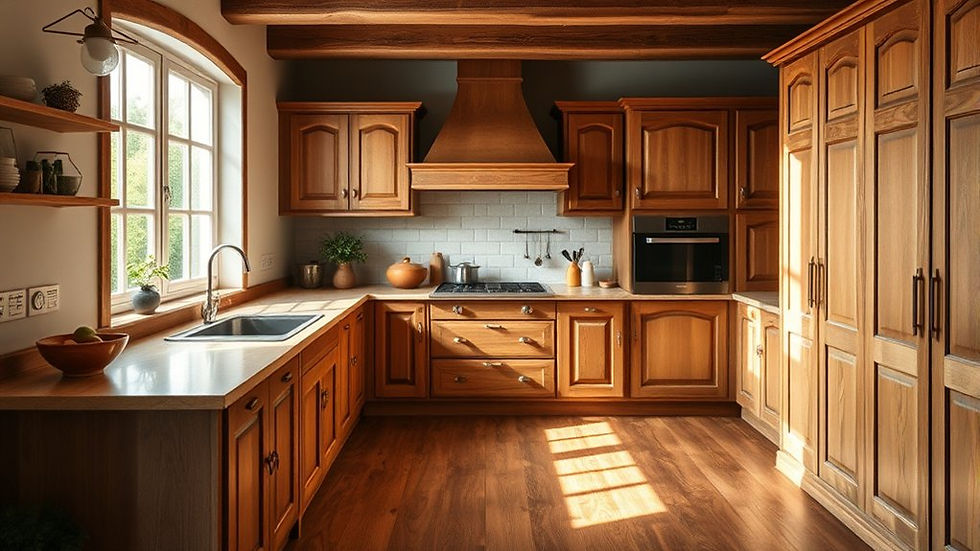Guide to Sustainable Materials in European Kitchen Design
- info9141069
- Aug 19
- 6 min read
Designing a kitchen that harmonizes style with sustainability can seem daunting, but the right approach can transform your space into an eco-friendly haven. Did you know that the kitchen is often the most resource-intensive area of a home? As homeowners increasingly seek ways to reduce their environmental footprint, understanding how to incorporate sustainable materials into European kitchen design becomes essential. This article is crafted for eco-conscious homeowners and designers looking to create beautiful, functional kitchens without sacrificing the planet. We’ll delve into the benefits of responsibly sourced woods, such as FSC-certified oak and beech, and explore innovative recycled materials that not only lower waste but also enhance aesthetic appeal. Additionally, we’ll discuss the advantages of renewable bamboo cabinetry, low-VOC finishes for improved air quality, and biodegradable flooring options like linoleum. By embracing these sustainable materials, you can create a stylish kitchen that reflects your commitment to the environment while also meeting the demands of modern living.

Responsibly Sourced Wood
How does responsibly sourced wood benefit your kitchen design?
Choosing responsibly sourced wood for your kitchen not only enhances its aesthetic appeal but also promotes sustainability.
Responsibly sourced wood enriches your kitchen’s beauty while advancing sustainability.
Materials certified by the Forest Stewardship Council (FSC) ensure eco-friendly practices that minimize deforestation and safeguard ecosystems.
By selecting durable woods like oak, walnut, and beech, you contribute to a greener planet while enjoying timeless elegance. Additionally, investing in 100% solid wood cabinets ensures both quality and longevity in your kitchen design.
Invest in materials that support sustainable forestry.
Opt for woods with reputable certifications.
Consider the longevity and durability of your choices.
These decisions significantly lower your environmental footprint, making your kitchen both stylish and responsible.
For more eco-friendly design tips, see our guide on sustainable kitchen materials.
Recycled Wood and Composites
How can incorporating recycled wood and composites enhance kitchen design?
Incorporating recycled wood and composites into your kitchen design seamlessly marries eco-friendliness with modern aesthetics. By utilizing reclaimed timber from old structures or furniture, you not only reduce waste but also create distinctive features that add character to your space.
This sustainable approach supports a circular economy while ensuring your kitchen remains stylish and functional.
Opt for reclaimed wood for cabinetry or shelving.
Use composite materials for countertops that mimic natural wood.
Consider decorative elements, like wall panels, made from recycled materials.
This commitment to sustainability not only conserves natural resources but also aligns with contemporary design trends.
For more ways to incorporate eco-friendly materials in your home, see our guide on sustainable interior design.

Bamboo: A Renewable Alternative
Why Choose Bamboo for Eco-Friendly Kitchen Design?
Bamboo is an exceptional choice for eco-conscious kitchen design due to its rapid growth and renewability. This sustainable resource matures in just a few years, unlike traditional hardwoods, making it an environmentally friendly option.
Bamboo’s rapid growth and renewability make it perfect for eco-conscious kitchen designs.
Its lightweight yet sturdy nature makes bamboo ideal for cabinetry and shelving, blending practicality with style.
Bamboo complements modern European aesthetics with its sleek appearance.
Opt for responsibly sourced bamboo to support sustainable forestry practices.
Look for products that use low-impact adhesives to enhance indoor air quality.
By selecting bamboo, you contribute to a healthier home while enjoying a contemporary design.
For more sustainable material options, see our guide on eco-friendly kitchen solutions.
Reclaimed Materials for a Unique Touch
Incorporating reclaimed materials into your kitchen adds character and a rich history, making your space truly one-of-a-kind.
How can you further enhance this unique aesthetic with creative design choices?
Discover how mixing textures can elevate your kitchen while maintaining a commitment to sustainability.
Character and History
How can reclaimed materials enhance kitchen design?
Incorporating reclaimed materials into kitchen design can add character and history to the space. Salvaged wood and metal not only contribute a unique aesthetic but also promote sustainability by reducing waste and minimizing environmental impact.
By choosing reclaimed wood for cabinetry, homeowners can create stunning cabinet doors that tell a story while conserving natural resources.
Use salvaged wood for distinctive cabinetry or decorative elements.
Incorporate metal details from reclaimed sources for unique handles and trims.
Consider the overall design theme to ensure a cohesive look.
This sustainable approach not only enhances your kitchen’s charm but also aligns with eco-friendly practices.
For more insights on sustainable design choices, check out our guide on eco-friendly materials.
Rustic or Industrial Edge
How can reclaimed materials enhance kitchen design?
Incorporating reclaimed materials into your kitchen design not only adds a unique rustic or industrial flair but also promotes sustainability.
Using salvaged wood and metal elements minimizes waste by repurposing existing resources, thereby supporting a greener approach to home decor.
Salvaged Wood: Opt for reclaimed wood in cabinetry to reduce the need for new timber and contribute to environmental conservation.
Metal Accents: Integrate repurposed metal handles or trims to enhance the industrial style while embracing recycling.
Distinctive Character: Each reclaimed piece brings its own history, appealing to those who value eco-friendly and personalized design.
For more insights on creating a sustainable kitchen, check out our guide on eco-friendly design practices.
Low-VOC Finishes for Healthier Homes
How can you create a healthier kitchen environment with low-VOC finishes?
Incorporating low-VOC finishes into your kitchen design is an effective way to enhance indoor air quality and promote a healthier living space.
These eco-friendly options not only reduce harmful emissions but also offer a variety of colors and textures to personalize your cabinetry while remaining environmentally conscious.
Choose low-VOC paints and finishes that comply with strict eco standards.
Consider materials that are both sustainable and stylish for your kitchen.
Explore brands that prioritize health and safety in their products.
By opting for low-VOC finishes, you significantly contribute to a sustainable kitchen and healthier home. Additionally, using materials like solid maple, white oak, and birch can further enhance the eco-friendliness of your design.
For more insights on sustainable materials, check out our guide on eco-friendly home renovations.
Sustainable Worktop Options
Exploring sustainable worktop options reveals that both recycled glass and quartz countertops provide eco-friendly solutions for your kitchen.
But what other innovative materials can further enhance sustainability in your home?
Discover how these choices contribute to a greener lifestyle while elevating your space.
Recycled Glass Countertops
What Makes Recycled Glass Countertops a Sustainable Choice?
Recycled glass countertops are an excellent eco-friendly option due to their environmentally conscious production process. Made from post-consumer glass bottles and industrial byproducts, they help divert waste from landfills while significantly conserving natural resources.
This sustainable manufacturing approach results in a lower carbon footprint compared to traditional stone surfaces.
Energy Efficiency: They require less energy during production, making them a greener alternative.
Durability: Resistant to scratches, heat, and stains, they promote hygiene in your kitchen.
Aesthetic Appeal: Available in a variety of colors and patterns, they allow for unique, customized designs.
Consider exploring more about their practicality and maintenance in our guide on countertop care.
Durable Quartz Surfaces
Why Choose Quartz Surfaces for Sustainable Kitchen Worktops?
Quartz surfaces are an excellent choice for eco-friendly kitchen worktops due to their combination of durability and sustainable manufacturing.
Made from 90-95% natural quartz crystals and 5-10% resins, these surfaces require low maintenance while many manufacturers use recycled materials and adhere to energy-efficient practices.
Non-porous, resisting stains and bacteria
Long-lasting, often enduring a lifetime
GREENGUARD Gold certified options available
Choosing durable quartz not only enhances kitchen aesthetics but also supports a healthier indoor environment.
For further insights on sustainable materials, check out our guide on eco-friendly home renovations.
Eco-Friendly Flooring Choices
What’re the best eco-friendly flooring options for kitchens?
When selecting sustainable flooring for your kitchen, consider these top choices that balance aesthetics and environmental responsibility.
Reclaimed wood is a standout option, as it minimizes the need for new timber and adds a distinctive charm to your space, with each plank telling a unique story.
Natural linoleum, crafted from renewable materials like linseed oil, isn’t only biodegradable but also enhances indoor air quality.
Another excellent choice is bamboo flooring, which is lightweight and highly durable due to its rapid growth.
This modern flooring solution integrates well with contemporary designs, especially when paired with low-VOC adhesives for a healthier home environment.
Explore local suppliers for reclaimed wood.
Choose linoleum with a low environmental impact.
Opt for bamboo certified by sustainable practices.
For more on eco-friendly home improvements, check out our guide on sustainable living tips.
Conclusion
Incorporating sustainable materials in European kitchen design not only enhances aesthetic appeal but also promotes environmental responsibility. By choosing eco-friendly options, such as responsibly sourced wood and bamboo, you’re actively contributing to a healthier planet and improving indoor air quality. This commitment to sustainability can lead to long-lasting benefits, including reduced environmental impact and potentially lower maintenance costs over time. To further enrich your kitchen experience, consider exploring more tips and strategies in our guide to sustainable materials in European kitchen design. Take the first step towards a greener home today!







Comments